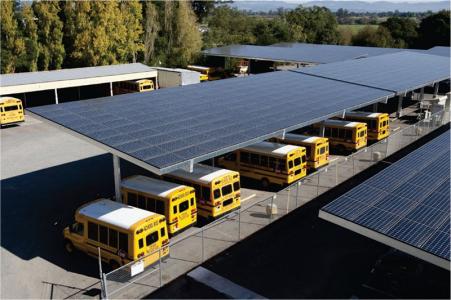Why Should a School District Go Solar?
SOLAR HELPS SCHOOL DISTRICTS SAVE MONEY
-
Solar reduces a school district’s operating costs. By providing a hedge against rising electricity costs, solar is an attractive mechanism for reducing a district's utility bills.1 Moreover, the decreasing cost of solar photovoltaic systems has made solar an increasingly accessible option for public schools. Onsite solar has helped numerous districts reduce their energy costs, creating savings that can be reinvested in teachers, textbooks, and expanded student services. For example, Oakland Unified School District recently installed 3.6 MW of solar across 16 schools and is expected to save $1.2 million annually on its utility bill, allowing the district to reinvest its savings into the classroom.2

Photo: The Solar Foundation
SOLAR HELPS SCHOOL DISTRICTS REDUCE THEIR ENVIRONMENTAL IMPACT
-
Solar photovoltaic systems produce electricity without releasing harmful greenhouse gases. Solar photovoltaics produce electricity without releasing carbon dioxide (CO2), methane (CH4), and nitrogen oxide (NOx) into the atmosphere. In 2012, Northern CA’s Mount Diablo Unified School District installed 12.1 MW of solar. Since the installation, the district has reduced its carbon emissions by 35,657 tons – equivalent of taking 6,800 cars off the road. Check out Mount Diablo High School’s solar dashboard for real time data on production, savings, and environmental benefits.3
-
Solar photovoltaics require very little water throughout their lifecycle, especially when compared to coal, natural gas, nuclear power, and hydroelectric plants4:
Electricity generation method Lifetime water consumption (gallons/MWh) Solar photovoltaic 2 Natural gas 172 Nuclear 572 Coal 692 Hydroelectric 9,000
Source: Burning Our Rivers. Wilson, Leipzig & Griffiths-Sattenspiel, 2011.
SOLAR PROVIDES EDUCATIONAL BENEFITS
-
Solar can provide schools with a new onsite technology tool that serves as a backdrop for compelling Science, Technology, Engineering, and Math (STEM) lesson plans. Many school districts are requiring that solar vendors include an educational component in the project contract. This means that existing STEM programs and academies can enhance their programs with a specific focus on energy. Schools that installed solar have been able to use their solar systems as a helpful hands-on tool for teaching important math, chemistry, and physics concepts to students of all ages. Moreover, onsite solar introduces our students to the clean energy resources and technology of the future.
-
There are many existing curriculum materials programs that easily benefit from onsite school solar energy systems as a unique STEM laboratory. Developed at The Lawrence Hall of Science at UC Berkeley, Global Systems Science is such a curriculum for grades 9-12 that focuses on science-related societal issues and can support a 1- to 2-year integrated science course or supplement existing biology, physics, chemistry, Earth science, or environmental science courses.

California teachers attending the Summer Solar Energy Academy, sponsored by SunPower Corp.
SOLAR IS AN INVESTMENT IN OUR COMMUNITY
-
Solar reduces local air pollution and protects community health. Fossil-fuel-based electricity generation releases NOx and SO2 (sulfur dioxide), all of which contribute to the formation of fine particulate matter and ground-level ozone (commonly referred to as smog).5 By replacing fossil fuel use, solar can help reduce local air pollution in communities where fossil fuel plants are located. The National Renewable Energy Laboratory projects that the adoption of solar can produce local health benefits, including decreased instances of cardiovascular and respiratory illnesses.
-
Solar demonstrates a commitment to our children’s future. Climate change presents a real threat to our children’s future. Investing in solar on our schools introduces our students to resource-conserving technologies and demonstrates how we can all take local action to help combat climate change.
-
Solar provides energy independence. Solar is a local source of energy, allowing us to produce electricity from sunlight that hits our rooftops and parking lots, instead of relying on resources that are extracted and imported from around the world.
-
The solar industry creates environmentally and socially responsible job opportunities: In 2014, the number of jobs in the solar industry outstripped that of the oil and gas sectors, as The Solar Foundation reported in their annual National Solar Jobs Census:
“As in previous years, California continues to lead in both solar employment and installed solar capacity. Of the 75,598 solar workers in the state, 60% are employed in the installation sector. By the end of 2016, California is expected to account for over 90,000 solar workers.”
The solar installation sector workforce is also more diverse than that of other energy sectors, with nearly a quarter of the workforce comprised of women and a significant minority population.6 In addition, there are new programs to assist veterans of the Armed Services in securing employment in the solar industry.
REFERENCES
1 http://www.thesolarfoundation.org/brighter-future-a-study-on-solar-in-us-schools/
3 http://169.199.90.240/kiosk/mdhs/
4 http://climateandcapitalism.com/wp-content/uploads/sites/2/2012/06/Burning-Our-Water.pdf
5 http://www.nrel.gov/docs/fy07osti/41998.pdf
6 http://www.thesolarfoundation.org/fact-sheet-state-solar-jobs-census-2015/

